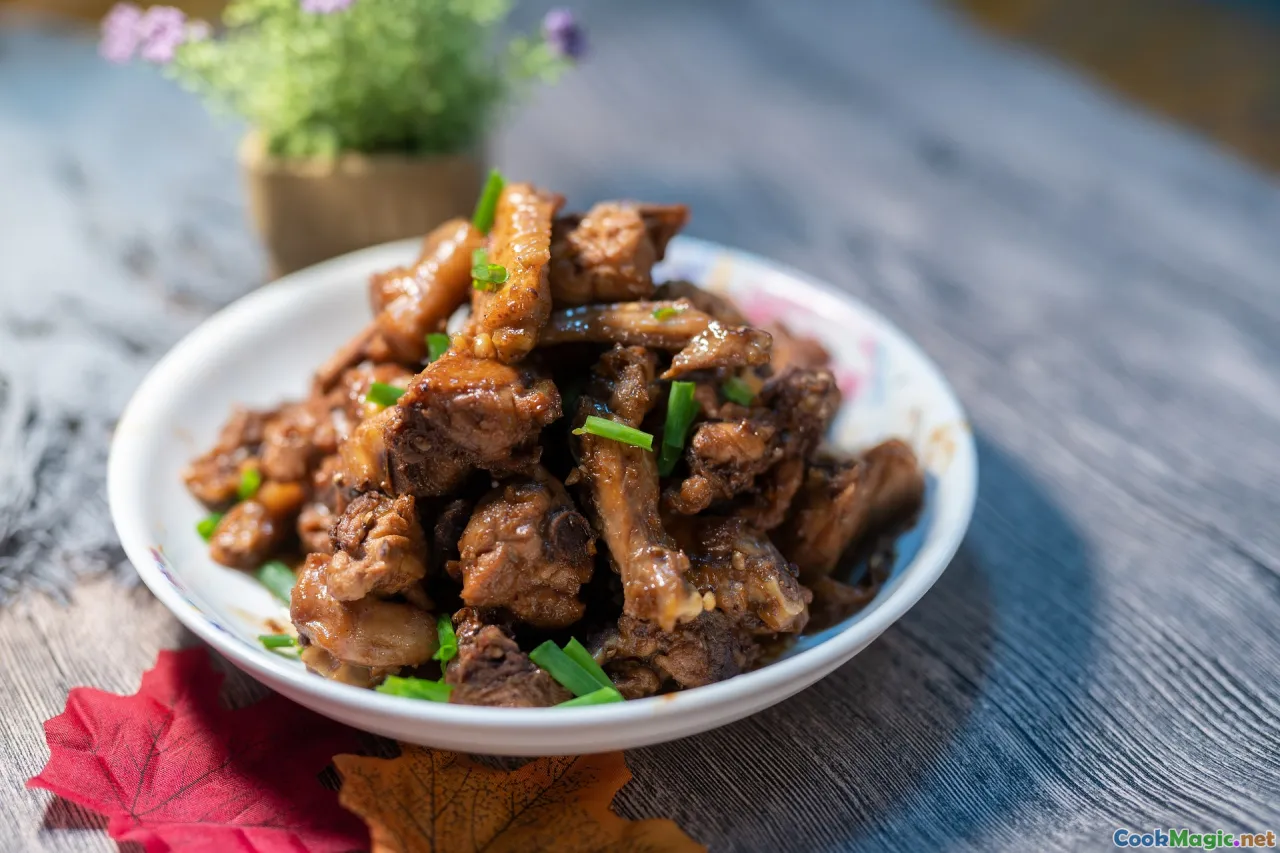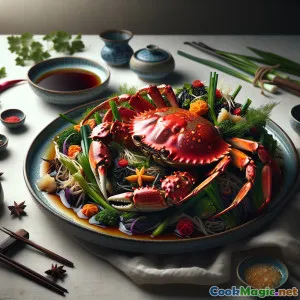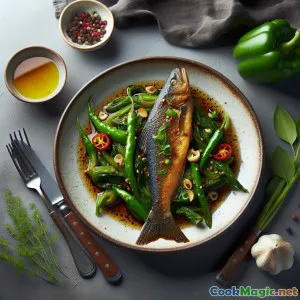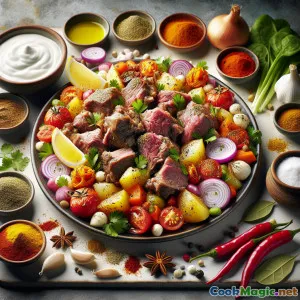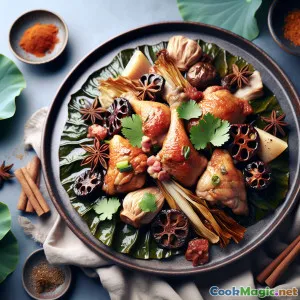
荷叶包香鸡
(Fragrant Chicken in Lotus Leaf Parcels)
(0 评论)食材
-
1200 grams Chicken thighs, bone-in skin-on, chopped into 3 cm chunks
(Or use 1 whole chicken chopped Chinese-style)
-
4 leaves 干莲叶
(Rinse and soak to soften; extra leaf helpful in case of tears)
-
6 pieces 干香菇
(Soak in hot water until pliable, then slice)
-
3 tbsp 绍兴酒
(Substitute dry sherry if unavailable)
-
3 tbsp 淡味酱油
(Adds salinity; adjust to taste)
-
1 tbsp 黑酱油
(For color and malty depth)
-
1 tbsp 蚝油
(Umami booster)
-
2 tsp Rock sugar or brown sugar
(Balances the salt and enhances gloss)
-
1 tsp 白胡椒粉
(Classic Cantonese heat)
-
1 tsp Chinese five-spice powder
(Aromatic backbone)
-
0.5 tsp Sand ginger powder (sha jiang)
(Optional but authentic warmth)
-
30 grams 新鲜生姜,切成薄片
(Layers with sand ginger for complexity)
-
4 cloves Garlic, lightly smashed
(Releases aroma without burning during steam)
-
3 stalks 葱
(Use whites in marinade, greens for garnish)
-
2 pieces 八角
(Tuck into parcels for slow perfume)
-
1 small stick 肉桂棒
(Break in half; enhances warmth)
-
2 tsp 烤芝麻油
(Finish the marinade)
-
2 tbsp 玉米淀粉
(Velvets the chicken and thickens juices)
-
1 tbsp Peanut oil or neutral oil
(Helps perfume transfer and prevents sticking)
-
1500 ml 沸水
(For soaking lotus leaves; not consumed)
-
10 grams 新鲜香菜叶
(Garnish at serving)
-
1 tsp 烤芝麻
(Optional garnish for texture)
(Or use 1 whole chicken chopped Chinese-style)
(Rinse and soak to soften; extra leaf helpful in case of tears)
(Soak in hot water until pliable, then slice)
(Substitute dry sherry if unavailable)
(Adds salinity; adjust to taste)
(For color and malty depth)
(Umami booster)
(Balances the salt and enhances gloss)
(Classic Cantonese heat)
(Aromatic backbone)
(Optional but authentic warmth)
(Layers with sand ginger for complexity)
(Releases aroma without burning during steam)
(Use whites in marinade, greens for garnish)
(Tuck into parcels for slow perfume)
(Break in half; enhances warmth)
(Finish the marinade)
(Velvets the chicken and thickens juices)
(Helps perfume transfer and prevents sticking)
(For soaking lotus leaves; not consumed)
(Garnish at serving)
(Optional garnish for texture)
营养
- 份量: 4
- 每份大小: 1 parcel (300g)
- Calories: 610 kcal
- Carbohydrates: 0 g
- Protein: 41 g
- Fat: 43 g
- Fiber: 1 g
- Sugar: 4 g
- Sodium: 1180 mg
- Cholesterol: 185 mg
- Calcium: 60 mg
- Iron: 2.7 mg
制作步骤
-
1 - Soften the lotus leaves:
Rinse the dried lotus leaves to remove dust. Submerge in a large bowl of boiling water until pliable, 8–10 minutes. Drain, pat dry, and trim tough stems.
-
2 - Soak and Prep Mushrooms:
Cover dried shiitake with hot water for 12–15 minutes until soft. Squeeze dry, reserve a few tablespoons of soaking liquid if clean, and slice caps.
-
3 - Build the marinade:
In a large bowl, combine Shaoxing wine, light and dark soy, oyster sauce, sugar, white pepper, five-spice, sand ginger, sesame oil, and 2 tbsp of the mushroom soaking liquid if using.
-
4 - Marinate the Chicken:
Add chicken, sliced ginger, smashed garlic, scallion whites, sliced shiitake, cornstarch, and peanut oil. Toss thoroughly to coat. Cover and refrigerate 40–60 minutes.
-
5 - Prepare steamer setup:
Bring water to a rolling boil in a steamer or wok fitted with a rack. Lightly oil a heatproof plate or bamboo steamer base to prevent sticking.
-
6 - Assemble Parcels:
Lay two lotus leaves in a cross. Spoon a quarter of the chicken mixture into the center. Tuck in a piece of star anise and a shard of cinnamon. Fold tightly into a neat parcel; secure with a strip of leaf or kitchen twine. Repeat to make four parcels.
-
7 - Steam until tender:
Arrange parcels seam-side down in the steamer, leaving space for steam circulation. Cover and steam over medium-high heat for 30–35 minutes until chicken is succulent and cooked through.
-
8 - Optional oven finish:
For a lightly smoky, toasty aroma, transfer parcels to a 220°C (425°F) oven for 6–8 minutes to gently char the leaf edges.
-
9 - Rest and unwrap:
Let parcels rest 5 minutes to reabsorb juices. At the table, snip twine and unfold leaves carefully to release the fragrant steam.
-
10 - Glaze the juices:
If desired, collect any pooled juices into a small pan and simmer 2–3 minutes to slightly thicken. Spoon back over the chicken.
-
11 - Garnish and Serve:
Scatter scallion greens, cilantro, and sesame seeds over the chicken. Serve immediately with plain jasmine rice or a crisp vegetable side.
Rinse the dried lotus leaves to remove dust. Submerge in a large bowl of boiling water until pliable, 8–10 minutes. Drain, pat dry, and trim tough stems.
Cover dried shiitake with hot water for 12–15 minutes until soft. Squeeze dry, reserve a few tablespoons of soaking liquid if clean, and slice caps.
In a large bowl, combine Shaoxing wine, light and dark soy, oyster sauce, sugar, white pepper, five-spice, sand ginger, sesame oil, and 2 tbsp of the mushroom soaking liquid if using.
Add chicken, sliced ginger, smashed garlic, scallion whites, sliced shiitake, cornstarch, and peanut oil. Toss thoroughly to coat. Cover and refrigerate 40–60 minutes.
Bring water to a rolling boil in a steamer or wok fitted with a rack. Lightly oil a heatproof plate or bamboo steamer base to prevent sticking.
Lay two lotus leaves in a cross. Spoon a quarter of the chicken mixture into the center. Tuck in a piece of star anise and a shard of cinnamon. Fold tightly into a neat parcel; secure with a strip of leaf or kitchen twine. Repeat to make four parcels.
Arrange parcels seam-side down in the steamer, leaving space for steam circulation. Cover and steam over medium-high heat for 30–35 minutes until chicken is succulent and cooked through.
For a lightly smoky, toasty aroma, transfer parcels to a 220°C (425°F) oven for 6–8 minutes to gently char the leaf edges.
Let parcels rest 5 minutes to reabsorb juices. At the table, snip twine and unfold leaves carefully to release the fragrant steam.
If desired, collect any pooled juices into a small pan and simmer 2–3 minutes to slightly thicken. Spoon back over the chicken.
Scatter scallion greens, cilantro, and sesame seeds over the chicken. Serve immediately with plain jasmine rice or a crisp vegetable side.
关于 荷叶包香鸡 :的更多信息
Overview
Lotus Leaf Wrapped Fragrant Chicken, or He Ye Ji, is a celebratory Cantonese classic that marries marinated chicken with the haunting perfume of lotus leaves. When the parcel is opened at the table, a plume of aromatic steam announces a dish shaped as much by tradition as by technique. The lotus leaf does more than look beautiful: it traps moisture, infuses gentle tea-like notes, and turns everyday pantry sauces—soy, Shaoxing wine, five-spice—into a complex, rounded bouquet.
This version favors accessible ingredients while honoring the original spirit. Bone-in, skin-on chicken thighs stand in for a chopped whole bird, delivering succulent texture with minimal fuss. Dried lotus leaves, widely available in Asian markets, are softened in hot water, then folded into parcels that steam to tenderness and optionally take a brief oven kiss for a toasty finish.
Why It Works
- Moisture management: Wrapping creates a self-basting environment. Cornstarch in the marinade lightly coats the chicken, helping juices cling rather than run.
- Layered aromatics: A blend of light and dark soy, Shaoxing wine, sugar, and five-spice builds sweet-savory depth. Star anise and cinnamon tucked into each parcel release a slow, rounded perfume.
- Lotus leaf magic: The leaf’s natural oils impart a subtle, uniquely “green” fragrance—something between oolong tea and hay—complementing umami sauces without overpowering them.
Ingredient Spotlight
- Lotus leaves: Choose leaves that are intact with minimal holes. After soaking, they should be pliable but not fragile. A spare leaf is insurance against tears and can be cut into straps to secure parcels.
- Shaoxing wine: The heart of many Cantonese marinades. If substituting dry sherry, pick an amontillado or oloroso for a similar nutty warmth.
- Five-spice and sand ginger: Five-spice lays the foundation; a pinch of sand ginger (sha jiang) brings a camphorous zing beloved in classic banquet kitchens.
- Chicken choice: Thighs are forgiving, but a traditional chopped whole chicken delivers a pleasing mix of textures—breast, thigh, a little bone for savor.
Tips & Notes
- Marinating time: Forty to sixty minutes is ideal for seasoning without over-salting. For meal prep, marinate up to 12 hours refrigerated; let the chicken sit at room temperature 20 minutes before cooking.
- Wrapping technique: Cross two leaves to create a thicker barrier. Fold as you would a present—sides in, then top and bottom—pressing out air for compact parcels that steam evenly.
- Steaming setup: Ensure vigorous steam before adding parcels, then maintain a steady simmer. If steam weakens, extend time a few minutes; chicken should be fully opaque with clear juices.
- Optional finish: A brief oven blast or a hot dry skillet will lightly char the leaves, releasing extra aroma and adding a touch of smokiness.
- Sauce polish: Reduce the steamed juices for a glossy spoon-over finish. A few drops of sesame oil at the end add sheen.
History and Cultural Significance
In southern China, lotus is a symbol of purity, rising pristine from the mud. The leaf has long been used as culinary wrapping—at once vessel, flavoring, and presentation. While dim sum fans may know lo mai gai (sticky rice in lotus leaf), He Ye Ji belongs to the banquet tradition: a centerpiece dish unveiled amid conversation and celebration. Its roots stretch into Cantonese home kitchens as well, where cooks developed thrifty ways to extract maximal aroma from simple ingredients, relying on time, steam, and balance rather than excess.
The dish showcases Cantonese ideals: clarity of flavor, harmony, and textural tenderness. Sauces don’t drown the chicken; they whisper around it. The lotus leaf’s scent is unmistakable yet gentle, an aromatic signature that elevates even humble cuts of poultry.
Serving Suggestions
- Pair with plain jasmine rice or airy steamed rice cakes to catch the savory juices.
- Offer quick-tossed greens—gai lan with garlic, choy sum, or a cool cucumber salad—to refresh the palate.
- A light brothy soup (winter melon or chicken corn) completes a classic Cantonese meal arc.
Variations
- Herbal lift: Add a few sprigs of cilantro stems or thin slices of fresh lemongrass for brighter, citrusy notes.
- Earthy richness: Mix in roasted chestnuts or water chestnuts for texture and sweetness.
- Spicy edge: Stir in a pinch of chili flakes or a drizzle of chili oil right before serving—nontraditional but delightful.
- Gluten-conscious: Use a gluten-free soy sauce and oyster sauce alternative if needed.
Troubleshooting
- Parcels leaking: Double-wrap with an extra leaf or use kitchen twine. Small tears are fine if the fold lines seal them.
- Too salty: Reduce light soy by 1 tablespoon next time, and use low-sodium stock or plain water instead of mushroom soaking liquid.
- Bland results: Ensure a full rolling steam and don’t skimp on marinating time; the lotus leaf’s contribution is subtle and needs the savory backbone of the marinade.
Personal Notes
What I love most about this dish is its quiet theater: the table falls silent for a moment as the parcel opens and an herbal cloud escapes. The flavors are familiar—soy, ginger, wine—yet the lotus leaf refracts them into something new. It’s comfort food dressed for a celebration, a recipe that rewards calm pace and simple care. Make it when you want to cook with intention, and let the steam do the rest.



